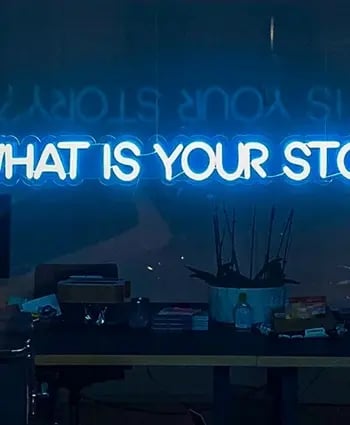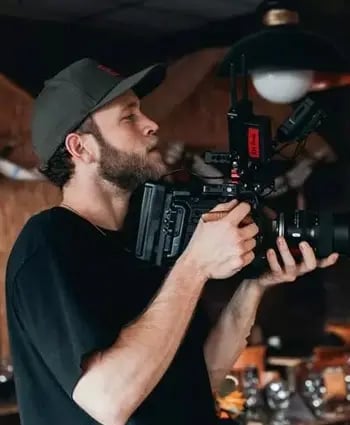The Essential Guide to B2B Video Marketing on Social Media
Guide covers B2B social video marketing: every step plus examples, recognizing video as key content
 Think back to the last video you watched.
Think back to the last video you watched.
I'm willing to bet you saw it on social media.
You've no doubt heard mind-boggling stats like 500 million people watching Facebook video daily, or 8 billion Snapchat views every day.
Here's the truth: video is the most important kind of content you can share on social today, whether that's YouTube, Facebook, Twitter or LinkedIn (or newer kids on the block like Instagram and Snapchat).
And that's even more true for B2B than it is for B2C.
With the popularity, creation and consumption of video marketing skyrocketing across all audiences, now is the time for B2B businesses and brands to think seriously about video content as part of their social marketing. Before it's too late (gulp).
But if you're totally new to using video as a B2B social tool, where do you start?
That's why we've written this guide. It covers every step of video marketing on social media for B2B brands, to help you get started or boost your results from the work you've already done. And we've included plenty of examples from B2B businesses along the way to inspire you.
Click the links below to jump to sections that interest you most, or keep scrolling for the full guide.
 Video Content Marketing Strategy Template
Video Content Marketing Strategy Template
Step away from confused, ad hoc projects. Create more strategic and effective video content.
Download our simple template for the planning framework you need to integrate video into your content marketing strategy.
The Essential Guide to Social Media Video Marketing for B2B Brands
- Why is Video on Social Important for B2B?
- Using Social Video to Achieve Your Goals Through the Funnel
- Gain Broad Awareness on Facebook
- Have Conversations on Twitter
- Drive Conversion on LinkedIn
- Create Connections on Instagram
- Share Stories on Snapchat
- Creating Effective Social Video for Your B2B Audience
- Sharing, Spreading and Targeting With Video on Social
- 7 Quick Tips & Ideas to Get Started with B2B Social Video
Why is Video on Social Important for B2B?
First, a simple definition: social video means any type of video content used on social media platforms.
That can range from a carefully-crafted explainer video shared on your LinkedIn company page, to a fun and spontaneous Snapchat video about your team away day shot on your iPhone.
No matter what it looks like, social video is a vital part of any modern B2B content marketing strategy. Here are four important reasons why:
1. Video is more eye-catching and engaging
There's no way about it. Video is more immediately grabbing than any other medium. It stands out from other, less dynamic content, in the way it catches our eye and refuses to let go.
Words take some time to decipher, but we interpret images in less than 1/10th of a second. Add motion and sound and you've got the ultimate attention-grabbing combo, it's hardwired into the instinctive part of our brains, back from when we kept an eye out for sabre-toothed tigers.
[Actual footage of someone entranced by a video.]
Not to mention, visual and aural content is more likely to generate emotions and build trust in your audience. We're social creatures who like connecting with others, and video comes closest to actually talking to another human being.
That's why we're all drawn to it, and why it's a powerful tool for your B2B marketing arsenal.
2. Social networks increasingly prioritise video
Across every social channel, video gets more views, shares and engagement than any other kind of content. Video is the most shared type of brand content on Facebook, and both Facebook and Instagram users find video 5x more engaging than images.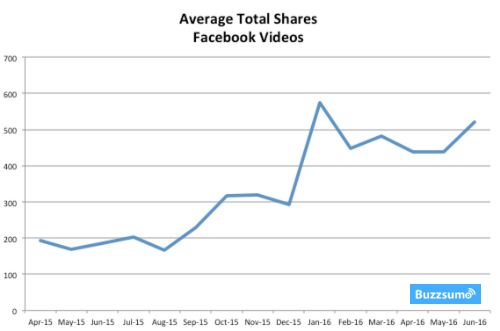 In fact, a study of the top 10 brand pages on Facebook found that videos are shared 12x more than text and link posts combined.
In fact, a study of the top 10 brand pages on Facebook found that videos are shared 12x more than text and link posts combined.
Just check out this graph. When Buzzsumo analysed 25 million Facebook posts from 10,000 publishers they found average video shares had more than doubled in a single year.
All this means that social networks, particularly Facebook, are prioritising video over all other kinds of content. Over the past few years the channel has been steadily promoting video to the top of its users' news feeds, thanks to its consistently high engagement. Now others like Instagram and Twitter are following suit.
In short: social is now dominated by video.
3. Your competitors are catching on quickly
Today 70% of B2B marketers are using video, and 82% of them have reported success with video marketing. Most tellingly, for 63% of B2B marketers video spend is on the rise.
Social video may have been a B2C game for a long time, but thousands of B2B businesses and brands already finding ways to raise awareness and convert leads with video marketing on social media. What's the likelihood your competitors are among them?
Now is the time to get involved with B2B social video, while the landscape is still shifting and there are lots of opportunities to be had.
4. Video delivers better ROI
There's no point in using any type of marketing if it's not going to drive the results you're looking for. Luckily video has an excellent track record in generating ROI for B2B brands.
In today's modern world, 70% of B2B buyers and researchers watch videos throughout their path to purchase. It's not just junior employees either: 75% of senior executives watch videos while at work, and 59% of them actually prefer video over text. Video has become a key part of the B2B buying experience.
That's why 71% of marketing professionals say video is better at driving conversions than other types of content. In fact, 52% of marketing professions report that video has the best ROI of all content types. It's a slice of your marketing mix you don't want to miss out on.
I'll leave you with an example to round up. Remember that great ad featuring Jean-Claude Van Damme doing the splits? This one:
Volvo Trucks sell heavy-duty trucks to businesses around the world. On the face of it they sound like a boring brand, but they ran an incredibly successful social video marketing campaign centred around that advert. It generated over 100 million views, a significant increase in brand recall and awareness, and a 23% increase in sales.
The takeaway? No matter what you sell, never presume that social video can't work for you.
Using Social Video to Achieve Your Goals Through the Funnel
For some, video on social media conjures up ideas of generating "buzz" or, God forbid, going viral.
In fact social video can be used to do so much more than just get your brand seen. Video marketing on social channels can support every area of your existing marketing strategy, and help you launch entirely new marketing campaigns too. Video on social is often associated with just the top of the marketing funnel, when potential customers are first discovering you and how you can help them.
Video on social is often associated with just the top of the marketing funnel, when potential customers are first discovering you and how you can help them.
This is also known as the awareness stage of the buyer's journey.
But your leads don't suddenly stop using social media as they get closer to sale. There are still numerous opportunities to keep connecting with them (which is important, since it takes at least 6 touches before the average member of your audience is ready to become a sales lead).
Plus social media gives marketers the ability to keep track of individuals in their audience better than ever before thanks to clever targeting and retargeting. By using the right content at the right stages of awareness we can tailor marketing messages ever more to the individual and get ever optimised results. So you've got no excuse to miss out on those conversions.
The truth is that social video can help you engage with your B2B audience at all stages of the buyer's journey, as they become familiar with your brand, consider using your product or service, and ultimately decide to buy from you.
With that in mind, let's run through 4 of the most common business goals you can achieve with social media video marketing:
Raising awareness
As we've covered, video is ideally suited to grab your audience's attention while they're scrolling on social and get them interested in your brand.
Whether you're drawing in leads with big, bold, spectacular brand films or answering their questions with useful how to videos, the aim when raising awareness is simply to provide something interesting, engaging and valuable, so viewers will remember you and engage further with your brand. Then it's the job of other pieces of video content to move potential customers further down the funnel.
We recommend engaging your audience with a simple story and strong emotions. Consider filming short documentaries on an interesting topic, or tapping into the values you know your audience care about.
Best types of awareness video content:
- Brand films
- How-to videos
- Video documentaries
- Emotional videos
Zendesk are customer service software providers, and they know how to use fun, quirky social video to introduce new leads to their services.
This brand film has been used across many of their social channels, both organically and as a paid social ad, to pique the curiosity of their audience and give potential customers a sense of their brand values.
Building trust
Once leads have heard of your business or brand, social video gives you a unique opportunity to stay top of mind. With new pieces of video content you can continue building their trust over time.
At this point it's more important than ever to be authentic and real. Your audience want to know what you're like as a business and what you can do for them. If they feel like you're not being honest, they'll quickly switch off. Social media isn't the place for over-the-top or bombastic (and clearly false) marketing messages.
Instead, focus on showing interesting case studies from your customers. Focus on what's real: tell a genuine story, with the true thoughts and feelings of your client. Or create short videos focusing on your business, your team and your culture to give leads a sneak peek behind the scenes.
Best types of trust-building video content:
- Case study videos
- About us / culture videos
Squarespace provide websites, hosting and content management systems. In this short and personality-packed success story they show how one of their clients use those services.
The video works because Squarespace isn't the focus; their offering is just included naturally. Instead the story follow the hard work of the customer and what they were able to achieve.
Generating leads
This is the area with the most potential, because even today very few B2B businesses do it well. Once leads start moving through the consideration and decision stages, you can use social video to encourage them to convert.
Here you'll need to get a bit more explicitly focused on your offering. That doesn't mean you can't still be fun and interesting, though. Remember this is still social and your leads still have a lot vying for their attention.
Use short, simple, to-the-point videos to explain the benefits of your product or service. Or promote one of your best performing resources, webinars, or free trials to generate leads. Finally, the classic explainer video can be an effective piece of video content to encourage conversions from social, especially when supported by paid promotion.
Best types of conversion video content:
- Explainer videos
- Promotional videos
- Product / service videos
- Videos promoting resources / webinars / free trials
Moz are giants of the SEO and inbound marketing software world. They offer a range of useful services to help marketers do their jobs better.
This product video is simple but effective. In just 45 seconds they cover the major benefits and features of their tool along with screen capture of it in action. For those who have already engaged with the brand, this video offers a compelling reason to find out more.
Improving engagement
Social media is about conversations. Video gives you unparalleled potential to communicate with both customers and leads in a personal, instant and authentic way.
By creating content tailored to the needs and wants of your audience you can increase engagement with your videos. Try sending personalised Snapchats to answer leads' questions or using short Twitter videos to provide customer support. You'll have the chance to speak directly to your audience and understand what makes them tick.
Not only does this make your viewers feel more closely connected to your brand, it also improves customer retention, loyalty, and satisfaction.
Best types of engagement video content:
- Thank you videos
- Personalised videos
- Anything authentic
IBM embrace the power of social video with this fun Snapchat story giving viewers a tour around their offices in Rochester, Minnesota.
The quality of filming is obviously not the reason why you'd watch these clips. It's the realness that viewers tune in for, plus a chance to have their questions answered and see a part of the business they usually never have access to.
8 Steps to Building Your Social Media Video Marketing Strategy
Like all good marketing, good social video marketing starts with a solid plan.
You need to know what success looks like for you, what content you'll create to get there, and how you'll drive leads on to the rest of your marketing funnel across different media and platforms.
Ideally, you'll already have some form of social media strategy, even if it's not written down. If that's the case you have the simpler task of integrating video content into your existing plan for social. If you don't, then you'll need to create a simple social video strategy that can also be fleshed out with all the other types of content you want to use on your social channels.
Either way, read on for the 8 steps to creating a comprehensive social media video marketing strategy.
1. Set your goals
What do you want to achieve with social video? It's a deceptively simply question.
We covered four main goals you might want to focus on in the section above. But you'll need to get specific with your aims. Consider how video content on social media could help support marketing you're doing in other areas, such as boosting lead generation for your webinar series or improving customer loyalty.
For a long-term strategy we recommend picking two to three goals you really want to dedicate your social video marketing efforts to. Within your plan you can also specify more short-term objectives tied to specific product, services, resources or events.
2. Pick the metrics that matter
Once you've got your goals, it's important to work out how you'll measure their success. You want to pick a combination of relevant video metrics rather than vanity metrics like views alone. Without this step you'll never truly know when, or even if, you've achieved your goals.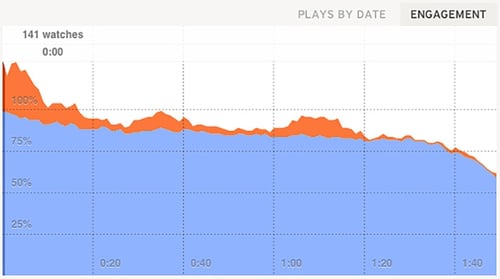
For example, if you're focusing on customer loyalty you should keep an eye on video engagement and the average length of time clients stay with you (maybe your Net Promoter Score too). See the image for what a video engagement graph looks like.
If you're aiming to improve lead gen, measure the conversion rate of visitors from social as well as the raw numbers of leads you can attribute to social video.
Looking to learn more? Read our simple guide to the 7 most important video metrics.
3. Get to know your audience
You can't create good social video, or any kind of video for that matter, without having a thorough understanding of your target audience. You need to know their concerns and desires to create engaging video content that guides them through the buyer's journey.
Speak to your customers and leads. Get basic information like demographics. Find out their job roles, industries and levels of experience. But the real power of audience research comes when you delve into their personalities, values and beliefs. Make sure you also understand which social channels your audience use, and for what purpose.
If you don't have them already, we recommend creating buyer personas that segment your audience into specific groups. This way you'll be able to more effectively resonate with different kinds of leads through different kinds of video.
4. Stand out from your competitors
Like I said, there's a lot of competition on social. You need to work out what you're going to do differently to catch the eye of your audience and convince them to engage more with your brand.
Assess the major competitors in your market. What social video are they using? What success have they found? What's already out there to inform, inspire and entertain your audience? Make a note of any opportunity gaps you find, or things your audience want that aren't currently being offered on social.
Don't forget: it's not just your direct competitors you've got to beat. Potential customers also spend their time on social media speaking to family and friends, viewing news and branded content, and looking at funny dog memes. Your aim is to capture your audience's attention amidst all that.

[This is what you're up against.]
5. Express your brand
So, what makes your business different? What do customers love about you? What are your most important values? What drives everything you do?
Each piece of social video you create should help to reinforce your brand and your USP. That's why you need to be clear when starting out how you want to be seen and what core messages you want to communicate.
This can be formulated as a series of short phrases describing how your video content should portray your business.
For example:
- Professional but authentic and relaxed
- Experts in our industry
- Always improving our technology and tools
- A team of friendly eggheads
6. Decide on your channels
In all areas of life it's important to pick your battles. Things are no different here. Yes, you could create video content for every social media platform under the sun, but is there any point?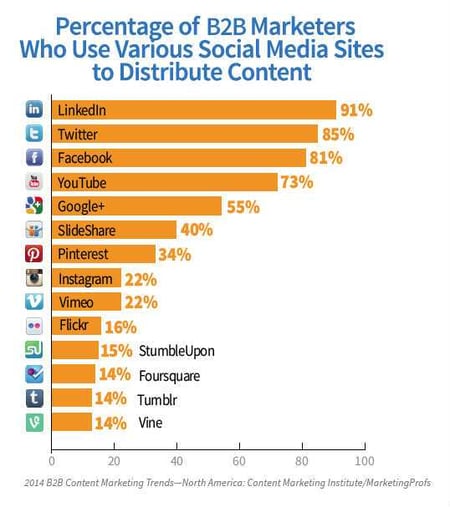 When it comes to choosing which social channels to focus on, you're going to need to reference all the research you've done so far. What are your goals for social video?
When it comes to choosing which social channels to focus on, you're going to need to reference all the research you've done so far. What are your goals for social video?
Where do your audience already spend their time? Where will it be easiest for you to stand out? And which channels are most in-line with your brand?
Look at this graph. LinkedIn, Twitter and Facebook are the social channels most saturated already with B2B content, but there's still plenty of room to take advantage of.
Also, consider the time and resources available to you. A smaller marketing team generally means dedicating yourself to fewer platforms (unless you outsource). To do social video well we recommend focusing on no more than four or five channels.
7. Develop your video USP
Now it's time to develop a unique proposition for every social channel you picked. Each has its own culture, norms, and expectations. How will you deliver what your audience want to see o
Written by Lydia Cockerham Copywriter for Venture Videos — a full-service video production agency that specialises in producing creative videos & campaigns that get real results.

